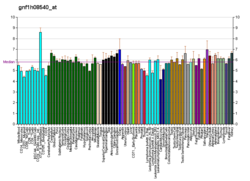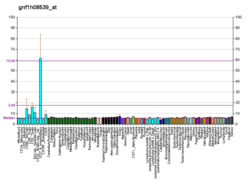Protein-coding gene in the species Homo sapiens
| WDR36 |
|---|
|
| Identifiers |
|---|
| Aliases | WDR36, GLC1G, TA-WDRP, TAWDRP, UTP21, WD repeat domain 36 |
|---|
| External IDs | OMIM: 609669; MGI: 1917819; HomoloGene: 6536; GeneCards: WDR36; OMA:WDR36 - orthologs |
|---|
| Gene location (Human) |
|---|
 | | Chr. | Chromosome 5 (human)[1] |
|---|
| | Band | 5q22.1 | Start | 111,092,321 bp[1] |
|---|
| End | 111,130,502 bp[1] |
|---|
|
| Gene location (Mouse) |
|---|
 | | Chr. | Chromosome 18 (mouse)[2] |
|---|
| | Band | 18|18 B1 | Start | 32,970,278 bp[2] |
|---|
| End | 33,000,647 bp[2] |
|---|
|
| RNA expression pattern |
|---|
| Bgee | | Human | Mouse (ortholog) |
|---|
| Top expressed in | - Achilles tendon
- tibialis anterior muscle
- deltoid muscle
- skin of arm
- pancreatic epithelial cell
- testicle
- parietal pleura
- germinal epithelium
- gonad
- mucosa of ileum
|
| | Top expressed in | - primary oocyte
- epiblast
- lumbar spinal ganglion
- primitive streak
- secondary oocyte
- spermatocyte
- endothelial cell of lymphatic vessel
- embryo
- morula
- abdominal wall
|
| | More reference expression data |
|
|---|
| BioGPS | 
 | | More reference expression data |
|
|---|
|
| Gene ontology |
|---|
| Molecular function | | | Cellular component | - nucleolus
- nucleus
- nucleoplasm
- small-subunit processome
- Pwp2p-containing subcomplex of 90S preribosome
| | Biological process | - retina homeostasis
- regulation of axon extension
- ribosome biogenesis
- response to stimulus
- visual perception
- rRNA processing
- biological process
| | Sources:Amigo / QuickGO |
|
| Orthologs |
|---|
| Species | Human | Mouse |
|---|
| Entrez | | |
|---|
| Ensembl | | |
|---|
| UniProt | | |
|---|
| RefSeq (mRNA) | | |
|---|
NM_001110015
NM_001110016
NM_144863 |
|
|---|
| RefSeq (protein) | | |
|---|
| Location (UCSC) | Chr 5: 111.09 – 111.13 Mb | Chr 18: 32.97 – 33 Mb |
|---|
| PubMed search | [3] | [4] |
|---|
|
| Wikidata |
| View/Edit Human | View/Edit Mouse |
|
WD repeat-containing protein 36 is a protein that in humans is encoded by the WDR36 gene.[5][6][7]
This gene encodes a member of the WD repeat protein family. WD repeats are minimally conserved regions of approximately 40 amino acids typically bracketed by gly-his and trp-asp (GH-WD), which may facilitate formation of heterotrimeric or multiprotein complexes. Members of this family are involved in a variety of cellular processes, including cell cycle progression, signal transduction, apoptosis, and gene regulation. Mutations in this gene have been associated with adult-onset primary open-angle glaucoma (POAG).[7]
References
- ^ a b c GRCh38: Ensembl release 89: ENSG00000134987 – Ensembl, May 2017
- ^ a b c GRCm38: Ensembl release 89: ENSMUSG00000038299 – Ensembl, May 2017
- ^ "Human PubMed Reference:". National Center for Biotechnology Information, U.S. National Library of Medicine.
- ^ "Mouse PubMed Reference:". National Center for Biotechnology Information, U.S. National Library of Medicine.
- ^ Bernstein KA, Gallagher JE, Mitchell BM, Granneman S, Baserga SJ (Dec 2004). "The small-subunit processome is a ribosome assembly intermediate". Eukaryot Cell. 3 (6): 1619–26. doi:10.1128/EC.3.6.1619-1626.2004. PMC 539036. PMID 15590835.
- ^ Monemi S, Spaeth G, DaSilva A, Popinchalk S, Ilitchev E, Liebmann J, Ritch R, Heon E, Crick RP, Child A, Sarfarazi M (Mar 2005). "Identification of a novel adult-onset primary open-angle glaucoma (POAG) gene on 5q22.1". Hum Mol Genet. 14 (6): 725–33. CiteSeerX 10.1.1.542.5801. doi:10.1093/hmg/ddi068. PMID 15677485.
- ^ a b "Entrez Gene: WDR36 WD repeat domain 36".
Further reading
- Strausberg RL, Feingold EA, Grouse LH, et al. (2003). "Generation and initial analysis of more than 15,000 full-length human and mouse cDNA sequences". Proc. Natl. Acad. Sci. U.S.A. 99 (26): 16899–903. Bibcode:2002PNAS...9916899M. doi:10.1073/pnas.242603899. PMC 139241. PMID 12477932.
- Ota T, Suzuki Y, Nishikawa T, et al. (2004). "Complete sequencing and characterization of 21,243 full-length human cDNAs". Nat. Genet. 36 (1): 40–5. doi:10.1038/ng1285. PMID 14702039.
- Mao M, Biery MC, Kobayashi SV, et al. (2005). "T lymphocyte activation gene identification by coregulated expression on DNA microarrays". Genomics. 83 (6): 989–99. doi:10.1016/j.ygeno.2003.12.019. PMID 15177553.
- Andersen JS, Lam YW, Leung AK, et al. (2005). "Nucleolar proteome dynamics". Nature. 433 (7021): 77–83. Bibcode:2005Natur.433...77A. doi:10.1038/nature03207. PMID 15635413. S2CID 4344740.
- Pang CP, Fan BJ, Canlas O, et al. (2006). "A genome-wide scan maps a novel juvenile-onset primary open angle glaucoma locus to chromosome 5q". Mol. Vis. 12: 85–92. PMID 16518310.
- Hauser MA, Allingham RR, Linkroum K, et al. (2006). "Distribution of WDR36 DNA sequence variants in patients with primary open-angle glaucoma". Invest. Ophthalmol. Vis. Sci. 47 (6): 2542–6. doi:10.1167/iovs.05-1476. PMID 16723468.
- Hewitt AW, Dimasi DP, Mackey DA, Craig JE (2006). "A Glaucoma Case-control Study of the WDR36 Gene D658G sequence variant". Am. J. Ophthalmol. 142 (2): 324–5. doi:10.1016/j.ajo.2006.02.041. PMID 16876519.
- Kramer PL, Samples JR, Monemi S, et al. (2006). "The role of the WDR36 gene on chromosome 5q22.1 in a large family with primary open-angle glaucoma mapped to this region". Arch. Ophthalmol. 124 (9): 1328–31. doi:10.1001/archopht.124.9.1328. PMID 16966629.
- Weisschuh N, Wolf C, Wissinger B, Gramer E (2007). "Variations in the WDR36 gene in German patients with normal tension glaucoma". Mol. Vis. 13: 724–9. PMC 2765470. PMID 17563723.
- Miyazawa A, Fuse N, Mengkegale M, et al. (2007). "Association between primary open-angle glaucoma and WDR36 DNA sequence variants in Japanese". Mol. Vis. 13: 1912–9. PMID 17960130.



















